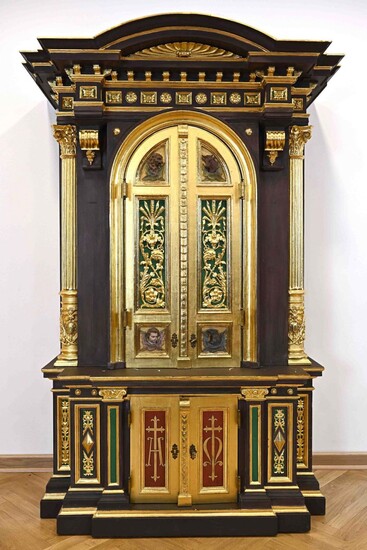Magnificent tabernacle, probably fr
Magnificent tabernacle, probably from the former St. Andrew church in Frankenried, around 1880, South German, in the New Renaissance style. In the lower and upper part two doors each, carved, colored and gilded, inside of the lower part indistinctly marked "Predella Frankenried", brass fittings, 2 -parts, height 210x137x67 cm, expertise Fr. Dr. Sabine Klotz, Augsburg, 2011. Rare piece, historical church furnishings. From the expertise of Dr. Sabine Klotz, Augsburg, 30.09.2011 "The object is a former, two-story tabernacle case in the style of the Neo-Renaissance, which originally belonged to an imposing high altar of a Catholic church. [.] The box-shaped body of the tabernacle on a rectangular pedestal with steps projecting towards the front is architecturally designed in the form of an aedicule and decorated with ornaments and Christian symbols related to the Eucharist. The lower tabernacle floor, articulated with a pair of pilasters, visually functions as a pedestal. The round-arched tabernacle door of the upper section is framed by volute brackets, fluted columns set into the corners, and a boldly profiled cornice spanned by a segmental pediment. All architectural elements are richly decorated with ornaments such as volutes, rosettes, leaf and vine shapes. The remaining surfaces of the corpus are covered with applied vine carvings and diamond stones. The iconography of the doors corresponds to the typical pictorial program of a tabernacle with Christian content. The two lower doors are decorated with double crosses and the letters Alpha and Omega formed from vines. On the inside, they are decorated with a vertically ascending tendril around which winds a scroll with the words "Sanctus Sanctus Sanctus / Dominus Deus Sabaoth", sung by all the faithful at the beginning of the Eucharistic Prayer. On the door panels on the upper tabernacle floor, ears of corn sprouting from the vines refer to the body of Christ. The four evangelist symbols, which can also be interpreted as the four beings in the eschatological context, fill the remaining fields of the door panels. On their inner side, two angels antithetically related to each other adore the monstrance. The recourse to the Renaissance as a stylistic reference point manifests itself not only in architecture and ornamental form, but also in the color scheme of the tabernacle, which is based on the ebony versions of the late 16th and 17th centuries. [.] Neo-Renaissance as a part of historicism was especially pronounced in the years between 1870 and 1890, when the tasteful preference of the Wilhelminian period also architecturally shaped state, civic, educational and church buildings. [.] With this high quality altar with rich carving and woodturning in the style of the Neo-Renaissance, a rare piece of historic church furnishings has been preserved, rarely found on the art market." Provenance Nagel, 696S, 6.6.2013, Lot 227 - German private collection
[ translate ]View it on
Sale price
Reserve
Time, Location
Auction House
Magnificent tabernacle, probably from the former St. Andrew church in Frankenried, around 1880, South German, in the New Renaissance style. In the lower and upper part two doors each, carved, colored and gilded, inside of the lower part indistinctly marked "Predella Frankenried", brass fittings, 2 -parts, height 210x137x67 cm, expertise Fr. Dr. Sabine Klotz, Augsburg, 2011. Rare piece, historical church furnishings. From the expertise of Dr. Sabine Klotz, Augsburg, 30.09.2011 "The object is a former, two-story tabernacle case in the style of the Neo-Renaissance, which originally belonged to an imposing high altar of a Catholic church. [.] The box-shaped body of the tabernacle on a rectangular pedestal with steps projecting towards the front is architecturally designed in the form of an aedicule and decorated with ornaments and Christian symbols related to the Eucharist. The lower tabernacle floor, articulated with a pair of pilasters, visually functions as a pedestal. The round-arched tabernacle door of the upper section is framed by volute brackets, fluted columns set into the corners, and a boldly profiled cornice spanned by a segmental pediment. All architectural elements are richly decorated with ornaments such as volutes, rosettes, leaf and vine shapes. The remaining surfaces of the corpus are covered with applied vine carvings and diamond stones. The iconography of the doors corresponds to the typical pictorial program of a tabernacle with Christian content. The two lower doors are decorated with double crosses and the letters Alpha and Omega formed from vines. On the inside, they are decorated with a vertically ascending tendril around which winds a scroll with the words "Sanctus Sanctus Sanctus / Dominus Deus Sabaoth", sung by all the faithful at the beginning of the Eucharistic Prayer. On the door panels on the upper tabernacle floor, ears of corn sprouting from the vines refer to the body of Christ. The four evangelist symbols, which can also be interpreted as the four beings in the eschatological context, fill the remaining fields of the door panels. On their inner side, two angels antithetically related to each other adore the monstrance. The recourse to the Renaissance as a stylistic reference point manifests itself not only in architecture and ornamental form, but also in the color scheme of the tabernacle, which is based on the ebony versions of the late 16th and 17th centuries. [.] Neo-Renaissance as a part of historicism was especially pronounced in the years between 1870 and 1890, when the tasteful preference of the Wilhelminian period also architecturally shaped state, civic, educational and church buildings. [.] With this high quality altar with rich carving and woodturning in the style of the Neo-Renaissance, a rare piece of historic church furnishings has been preserved, rarely found on the art market." Provenance Nagel, 696S, 6.6.2013, Lot 227 - German private collection
[ translate ]


